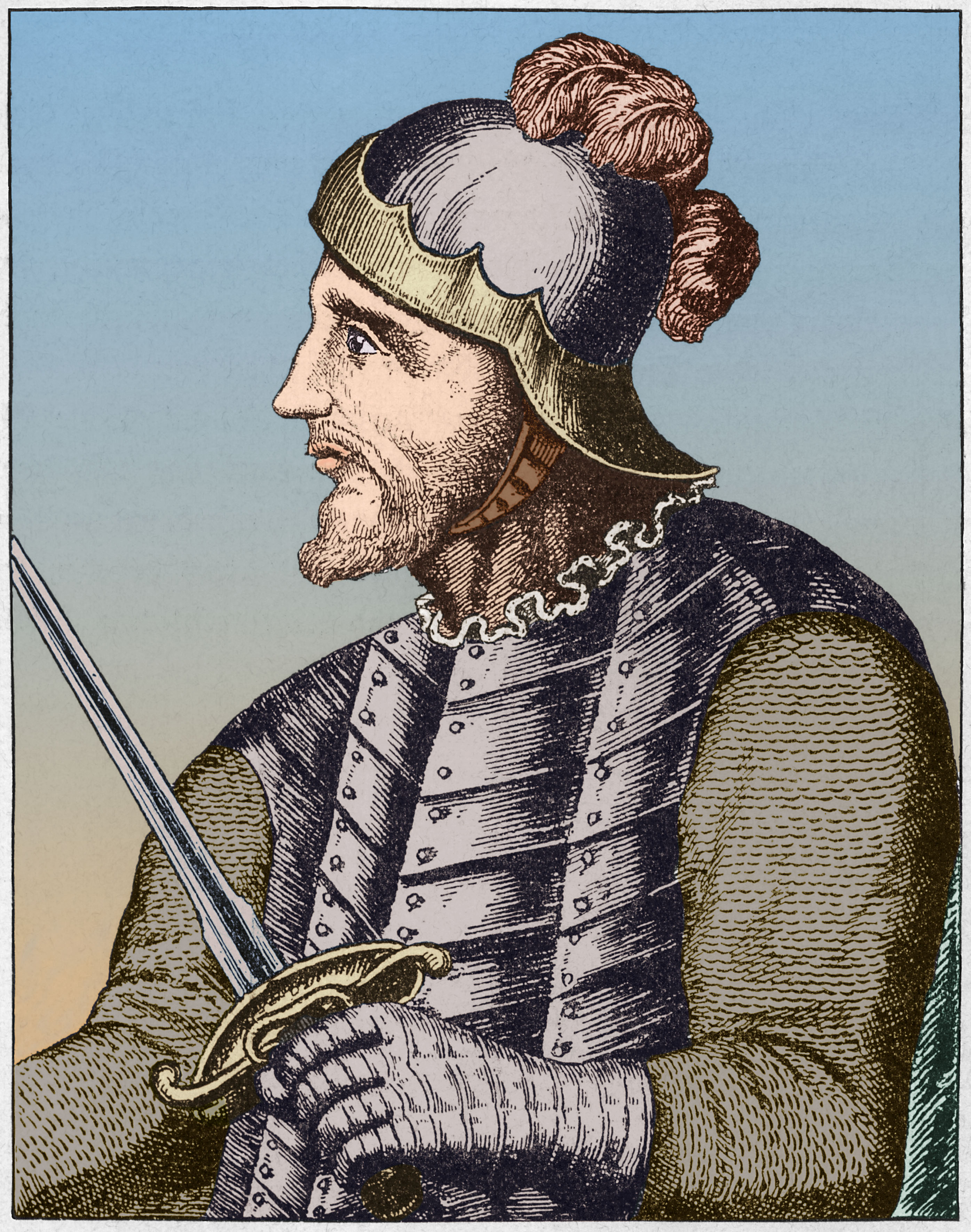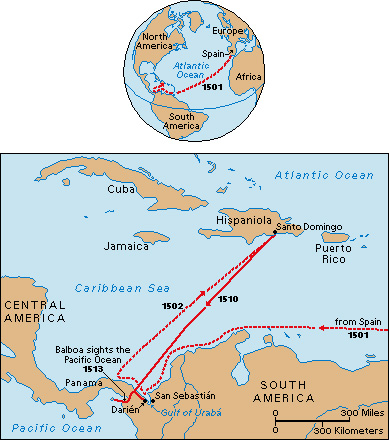Balboa, Vasco Núñez de << bal BOH uh, VAHS koh NOO nyayth day >> (1475?-1519), a Spanish conqueror and explorer, was the first European to see the eastern shore of the Pacific Ocean. He sighted the ocean in late September 1513, from a mountaintop in what is now Panama. Soon afterward, on Sept. 29, 1513, Balboa waded into the ocean and claimed it and all its shores for Spain. His findings opened Spanish exploration and conquest along the western coast of South America.

The Spaniards called the ocean the South Sea because it lay south of the Isthmus of Panama, a strip of land that links North and South America. In 1520 and 1521, Portuguese explorer Ferdinand Magellan sailed across the ocean during a voyage for Spain. He named the ocean Pacific, meaning peaceful.
Early life.
Balboa was born in Jerez de los Caballeros, Spain. His father, though perhaps a nobleman, had neither influence nor wealth. Young Vasco served in the household of a rich nobleman in Moguer, a port on Spain’s southwest coast. After Christopher Columbus reached America in 1492, many ships heading for the New World took on sailors and supplies at Moguer. Sailors who returned to the port from America often told stories about the new lands across the sea.
The opportunities for fame and wealth in the New World attracted Balboa. In 1501, he joined a Spanish expedition to South America. The party explored the north coast of the continent, including an area along the Gulf of Uraba in what is now Colombia. However, the expedition lacked enough people to attempt a settlement. In 1502 it sailed to the island of Hispaniola, the main Spanish base in America. Balboa had a hard time making a living on the island. For a time, he raised pigs there.
Rise to fame.
In 1509, the first Spanish expedition to colonize the mainland of South America left Hispaniola. Balboa attempted to join the expedition. But he had fallen heavily into debt, and people to whom he owed money prevented him from leaving Hispaniola.
On the mainland, the Spaniards established the settlement of San Sebastian along the eastern side of the Gulf of Uraba. In 1510, Balboa stowed away on a ship that carried supplies and new settlers to the colony. After reaching the mainland, the new settlers met the survivors of San Sebastian, who had abandoned the settlement because of dangerous Indians and a lack of food. The two groups united and returned to San Sebastian briefly. Balboa, who probably had more experience on the continent than any of the other settlers, suggested moving to the western side of the gulf. He had seen the area during his first expedition and knew that the Indians who lived there were more peaceful. The Spaniards moved to the site and established the town of Santa Maria de la Antigua del Darien, usually called Darien.
Balboa became acting governor of Darien. He led expeditions into Panama, conquering some Indians and making agreements with others in the area. In 1511, Indians told Balboa of a land called Tubanama, where he could find much gold. According to the Indians, this land was located across the mountains near a great sea.
Balboa knew he had only a weak claim to the governorship of Darien, and so he wanted to please King Ferdinand of Spain. Early in September 1513, Balboa led an expedition from Darien. The group of 190 Spaniards and a large number of Indians followed Indian trails across the isthmus. During the third week of the trip, Balboa’s Indian guides told him the ocean could be seen from a nearby mountain. Balboa, ordering his men to stay behind, advanced to the peak and sighted the Pacific.

The Spaniards found gold and pearls on the Pacific Coast. Balboa believed his findings would win him an appointment as permanent governor of Darien.
Later exploration.
Before the news of Balboa’s expedition reached Spain, Ferdinand appointed Pedrarias Davila, an elderly nobleman, to be the new governor. Pedrarias, as he was called, arrived in Darien in 1514. Ferdinand finally heard of Balboa’s findings and named him to serve under Pedrarias as governor of a new area on the Pacific coast of Panama. Balboa established the town of Acla on the north coast and transported materials across the isthmus to build ships for further conquest and exploration. The Spaniards completed two ships by 1518, and Balboa explored along the Gulf of Panama. He also considered an expedition to conquer the area now known as Peru.
Execution.
Pedrarias grew increasingly jealous of Balboa, who had become a powerful figure with many supporters. In 1518, the governor falsely accused Balboa of treason and had him arrested. Pedrarias arranged for a speedy trial, and Balboa was sentenced to death. On Jan. 12, 1519, Balboa and four friends were beheaded in the public square of Acla.
